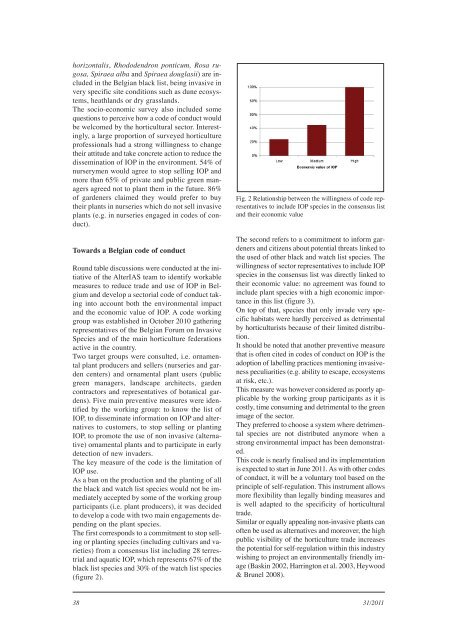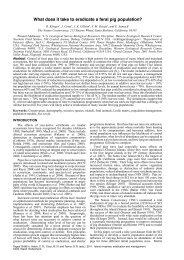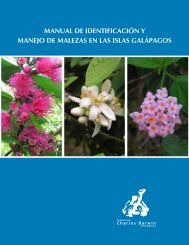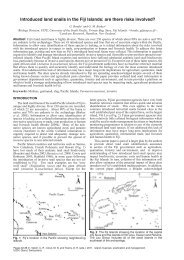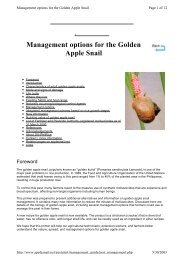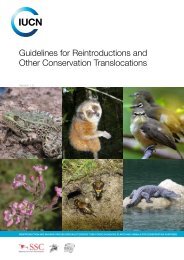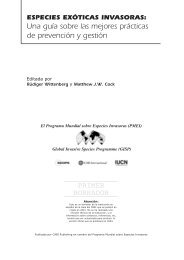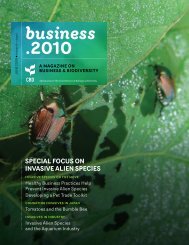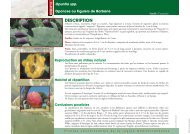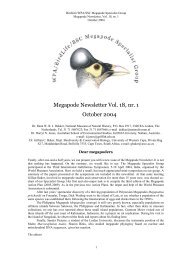Stampa Layout 1 - IUCN Invasive Species Specialist Group
Stampa Layout 1 - IUCN Invasive Species Specialist Group
Stampa Layout 1 - IUCN Invasive Species Specialist Group
You also want an ePaper? Increase the reach of your titles
YUMPU automatically turns print PDFs into web optimized ePapers that Google loves.
horizontalis, Rhododendron ponticum, Rosa rugosa,<br />
Spiraea alba and Spiraea douglasii) are included<br />
in the Belgian black list, being invasive in<br />
very specific site conditions such as dune ecosystems,<br />
heathlands or dry grasslands.<br />
The socio-economic survey also included some<br />
questions to perceive how a code of conduct would<br />
be welcomed by the horticultural sector. Interestingly,<br />
a large proportion of surveyed horticulture<br />
professionals had a strong willingness to change<br />
their attitude and take concrete action to reduce the<br />
dissemination of IOP in the environment. 54% of<br />
nurserymen would agree to stop selling IOP and<br />
more than 65% of private and public green managers<br />
agreed not to plant them in the future. 86%<br />
of gardeners claimed they would prefer to buy<br />
their plants in nurseries which do not sell invasive<br />
plants (e.g. in nurseries engaged in codes of conduct).<br />
Towards a Belgian code of conduct<br />
Round table discussions were conducted at the initiative<br />
of the AlterIAS team to identify workable<br />
measures to reduce trade and use of IOP in Belgium<br />
and develop a sectorial code of conduct taking<br />
into account both the environmental impact<br />
and the economic value of IOP. A code working<br />
group was established in October 2010 gathering<br />
representatives of the Belgian Forum on <strong>Invasive</strong><br />
<strong>Species</strong> and of the main horticulture federations<br />
active in the country.<br />
Two target groups were consulted, i.e. ornamental<br />
plant producers and sellers (nurseries and garden<br />
centers) and ornamental plant users (public<br />
green managers, landscape architects, garden<br />
contractors and representatives of botanical gardens).<br />
Five main preventive measures were identified<br />
by the working group: to know the list of<br />
IOP, to disseminate information on IOP and alternatives<br />
to customers, to stop selling or planting<br />
IOP, to promote the use of non invasive (alternative)<br />
ornamental plants and to participate in early<br />
detection of new invaders.<br />
The key measure of the code is the limitation of<br />
IOP use.<br />
As a ban on the production and the planting of all<br />
the black and watch list species would not be immediately<br />
accepted by some of the working group<br />
participants (i.e. plant producers), it was decided<br />
to develop a code with two main engagements depending<br />
on the plant species.<br />
The first corresponds to a commitment to stop selling<br />
or planting species (including cultivars and varieties)<br />
from a consensus list including 28 terrestrial<br />
and aquatic IOP, which represents 67% of the<br />
black list species and 30% of the watch list species<br />
(figure 2).<br />
Fig. 2 Relationship between the willingness of code representatives<br />
to include IOP species in the consensus list<br />
and their economic value<br />
The second refers to a commitment to inform gardeners<br />
and citizens about potential threats linked to<br />
the used of other black and watch list species. The<br />
willingness of sector representatives to include IOP<br />
species in the consensus list was directly linked to<br />
their economic value: no agreement was found to<br />
include plant species with a high economic importance<br />
in this list (figure 3).<br />
On top of that, species that only invade very specific<br />
habitats were hardly perceived as detrimental<br />
by horticulturists because of their limited distribution.<br />
It should be noted that another preventive measure<br />
that is often cited in codes of conduct on IOP is the<br />
adoption of labelling practices mentioning invasiveness<br />
peculiarities (e.g. ability to escape, ecosystems<br />
at risk, etc.).<br />
This measure was however considered as poorly applicable<br />
by the working group participants as it is<br />
costly, time consuming and detrimental to the green<br />
image of the sector.<br />
They preferred to choose a system where detrimental<br />
species are not distributed anymore when a<br />
strong environmental impact has been demonstrated.<br />
This code is nearly finalised and its implementation<br />
is expected to start in June 2011. As with other codes<br />
of conduct, it will be a voluntary tool based on the<br />
principle of self-regulation. This instrument allows<br />
more flexibility than legally binding measures and<br />
is well adapted to the specificity of horticultural<br />
trade.<br />
Similar or equally appealing non-invasive plants can<br />
often be used as alternatives and moreover, the high<br />
public visibility of the horticulture trade increases<br />
the potential for self-regulation within this industry<br />
wishing to project an environmentally friendly image<br />
(Baskin 2002, Harrington et al. 2003, Heywood<br />
& Brunel 2008).<br />
38 31/2011


